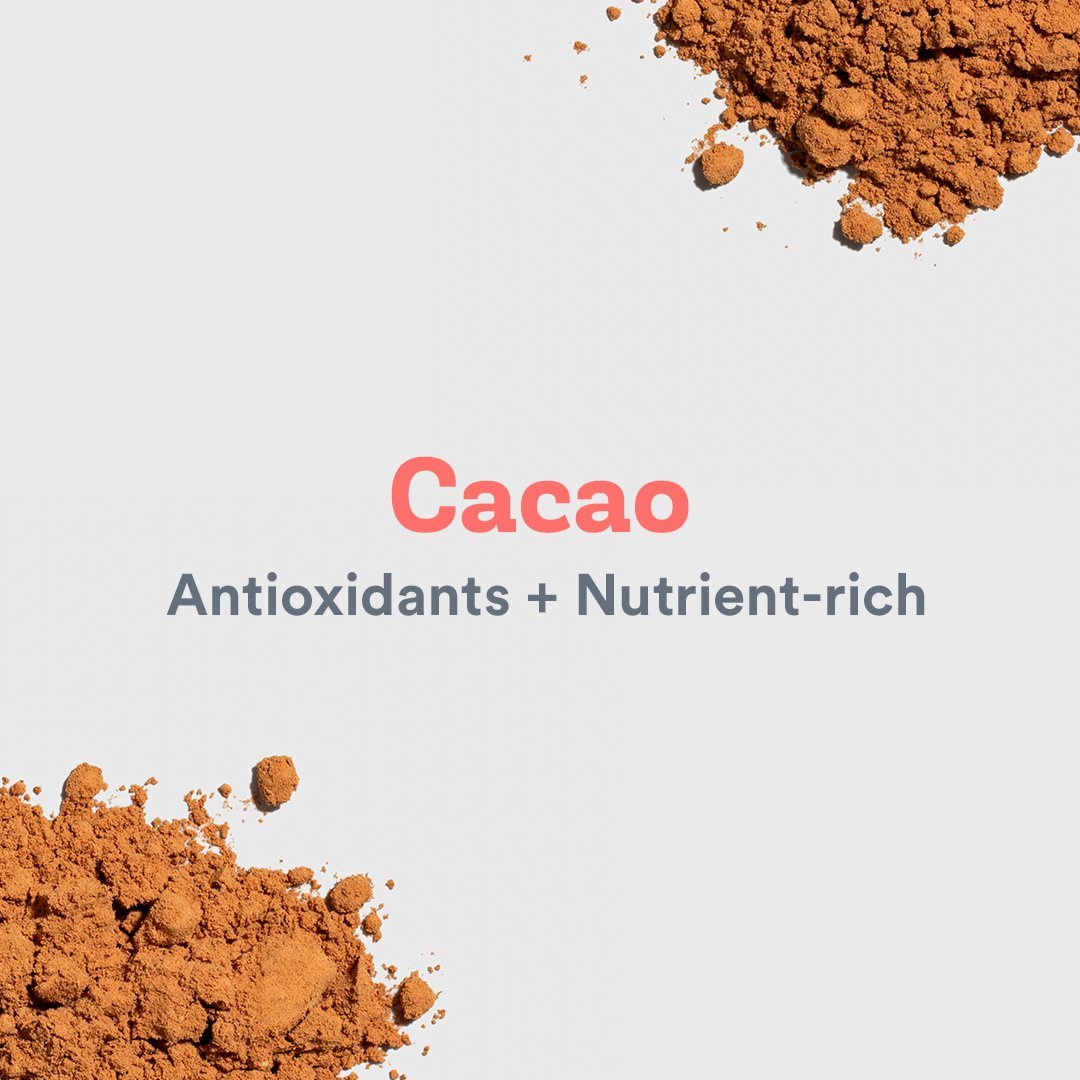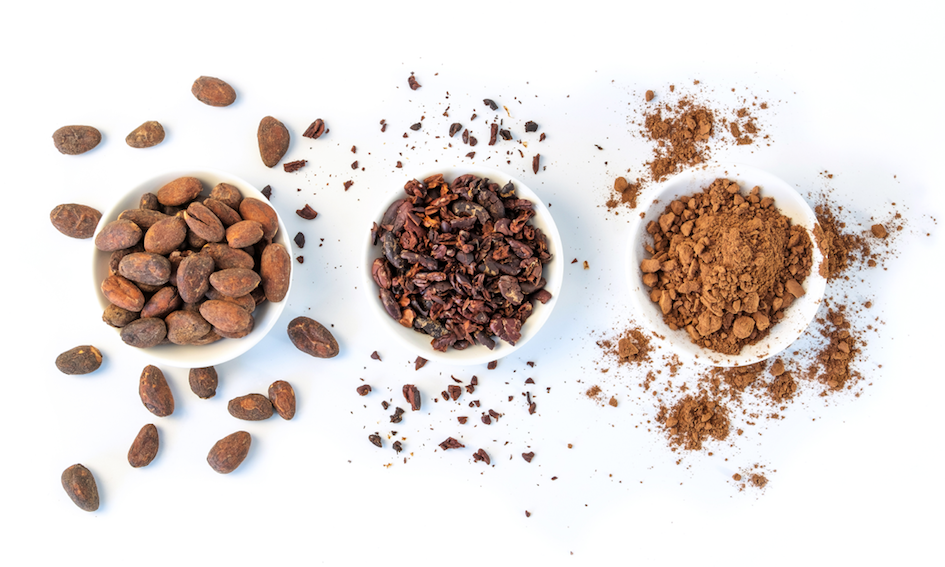
Scientific/Latin name: Theobroma cacao
Also known as: Cocoa, Cacao tree, Chocolate tree, food of the gods
Native to: Amazon basin countries in South America, like Ecuador, Colombia, and Venezuela (the Cacao used in all JOYÀ products is all ethically traded with farmers in the Dominican Republic).
Parts used: Seed (Bean) and Pulp
Top benefits: Antioxidant and Nutrient Rich, Mood and Cognitive Support

Cacao, from Pod to Bar
You probably know that your favorite dark chocolate bar starts out in plant form. You probably also know that the polyphenols and antioxidants in cocoa products have health benefits.
That might just be where your basic knowledge ends and your questions begin. Luckily we’re here to help bridge the gap. The answers lie in the simple cacao bean (which, as we’ll explain, isn’t really a bean at all).
We’ll explain what cacao is, outline its health benefits, and explain how you can enjoy your favorite chocolate treats even more. Let’s dive in!
What Is Cacao?
Cacao (or cocoa) beans are technically not beans or legumes, but rather the seeds of the fruit (pods) of the Theobroma cacao tree. This superfood is commonly enjoyed in a number of forms, including as cacao nibs (cacao beans that have been removed from their husks and broken down into small pieces) and cacao powder (cacao nibs that have been ground into a powder after most of the fat (aka cacao butter) has been mechanically pressed out).
Cacao can be consumed raw or roasted, but like so many food items, it’s most nutritious when consumed raw because cacao in its raw state hasn’t undergone any high heating and therefore retains more nutrients and health properties.
Health Benefits of Cacao
Health benefits that taste great are definitely a winning combination, but sometimes these benefits are lost when raw cacao powder is processed under high heat (becoming cocoa powder). At JOYÀ, we process our cacao products minimally, and the below health benefits are what you can expect when you use any JOYÀ Superblend that contains cacao.
Antioxidants
Every day your body comes into contact with external stressors. UV rays from the sun, chemicals in household cleaning products, pollution, and cigarette smoke are all aggressors that cause your body to produce molecules called free radicals (reactive chemicals containing oxygen).
Free radicals cause damage to healthy cells, and the damage can be repeated into new cells when they replicate. Antioxidants, which are found in particularly high concentrations in certain plants, are compounds that help the body combat cellular damage caused by free radicals.
When there is an imbalance between free radicals and antioxidants in the body, this is referred to as oxidative stress, and can contribute to various metabolic diseases, heart disease, brain disorders and age-related syndromes. It can even play a role in premature skin aging.
Cacao has been found to contain relatively high concentrations of certain compounds called flavanols, which can act as strong antioxidants. Cocoa flavanols have been associated with a number of health benefits, including anti-inflammatory actions, improving blood flow and the elasticity of arteries, and decreasing blood pressure.
When tested against a number of “superfruits” touted for their antioxidant properties, the antioxidant capacity of cacao powder, as measured by oxygen radical absorbance capacity (ORAC) tests, was significantly greater than that of blueberries, cranberries and pomegranate powder on a per gram basis, and the total flavanol content of cacao was significantly greater than all of the other fruit powders tested.

Nutrient-rich
Cacao is chock-full of nutrients. It’s a great source of dietary fiber to help keep you regular, and is one of the highest food sources of magnesium, a mineral needed for hundreds of biochemical reactions in our bodies and key to muscle and nervous system function. Just one ounce (28 grams) of cacao nibs contains 87 milligrams of magnesium.
Cacao is also an iron-rich food that can help combat iron deficiency. You can get about 5% (women) and 11% (men) of the recommended daily iron intake from one ounce of cacao nibs. It also contains calcium and potassium, two other important minerals that help with proper body and cellular function.

Mood
Many would argue that chocolate is the food with the greatest impact on mood! A number of studies have been conducted to evaluate whether chocolate (or its compounds) were capable of influencing mood, and in fact, improvement in mood or reduction of negative mood has been observed. Yet, it remains uncertain whether the effects of chocolate on mood are due to the sensory experience of taste or the pharmacological actions of its compounds.
Cacao has been found to contain compounds very closely similar to anandamide, a molecule whose name is taken from the Sanskrit word ananda, meaning "joy, bliss, delight", which binds to the same brain sites as cannabis. However, studies suggest that any association with pleasure from chocolate is likely to be indirect since these anandamide analogues have been found to inhibit the breakdown of anandamide in the body. To date, the anandamide-mood connection remains inconclusive.
Since all palatable foods stimulate the release by the brain of endorphins (chemicals produced by the brain that produce ‘feel-good’ sensations), researchers have suggested that the taste and feel of chocolate in the mouth is the most likely mechanism for the elevation of mood.
Cognitive support
Studies exploring the potential effects of Cacao on cognition are in relatively early days, yet showing some promise, suggesting possible neuro-modulatory and neuro-protective actions in humans. (1, 2) Cacao flavonoid compounds absorbed by the body appear to accumulate in brain regions involved in learning and memory.
It is suspected that the neurobiological effect of these flavanols is twofold: (1) via cellular interactions that promote nerve growth and function and brain connectivity, and (2) via blood-flow improvement and blood vessel development in the brain and sensory systems. Studies have shown protective effects of long-term flavanol consumption on neuro-cognition and cognitive decline in animal models of aging, dementia and stroke, and a few human observational studies appear to support these findings. Studies on more immediate benefits of cocoa flavanols remains limited and inconclusive, however research is ongoing.
Kick Up Your Cacao
Raw cacao can have a slightly bitter taste, which is why there’s usually some type of sweetener added to it. In JOYÀ products, we use only botanicals with a natural sweetness, such as natural coconut sugar. These ingredients enhance flavor naturally and safely in a way that won’t cause your blood sugar levels to spike and crash.
To enjoy the benefits of cacao in your daily life, add in a functional chocolate bar from JOYÀ.
Feed Your Inner Chocoholic
Sometimes, there is no substitute for the fudgy, cocoa-y goodness of pure, dark chocolate. That’s what you’ll find in every one of JOYÀ’s Functional Chocolate Bars.
Each bar is blended with pure, function-forward ingredients that deliver specific benefits based on what your body and mind need.
- Focus. Need to heighten your awareness and increase your brain power? This is the bar for you. In addition to Cacao, you’ll get Rhodiola, Ginkgo, Coffee, Coconut and Cacao Butter working synergistically to help you sustain energy and finish the goal.
- Zen. Calm your nervous system and support relaxation, even on your snack break. Cacao and Cacao Butter combine with Coconut, Chamomile, and Reishi Mushroom to help restore balance and support your stress response.
- Defend. Supporting your immune system has never been easier (or more delicious). Cacao and Cacao Butter blend together with adaptogenic Astragalus and Lion’s Mane Mushroom to support a healthier, more balanced immune response.
- Balance. Was your New Year’s Resolution to find more equilibrium in your schedule or in your life? Support it with this delicious bar of balance-boosting ingredients. Cacao, Cacao Butter, and two powerful adaptogens, Ashwagandha and Reishi Mushroom, help restore order when your body’s pendulum is too far to one side.
When you want chocolate, get it without any guilt. In fact, make it a functional chocolate bar and feel good about supporting your body with every decadent bite.
Cacao Pow
From antioxidants and nutrients to supporting your mood, if you ever needed a reason to indulge a little, you’ve got it. Make the indulgence even sweeter by getting your daily dose of cacao in functional foods available from JOYÀ.
Your body and your taste buds will thank you.
The health research presented in this article is for informational use only. It is not a replacement for professional health advice and should not be construed as a recommendation of specific products. The products sold on this website are not intended to diagnose, treat, cure, or prevent any disease. This information does not provide dosage or format recommendations or possible drug interactions, and accordingly, should be used with the advice of a qualified health care practitioner.


